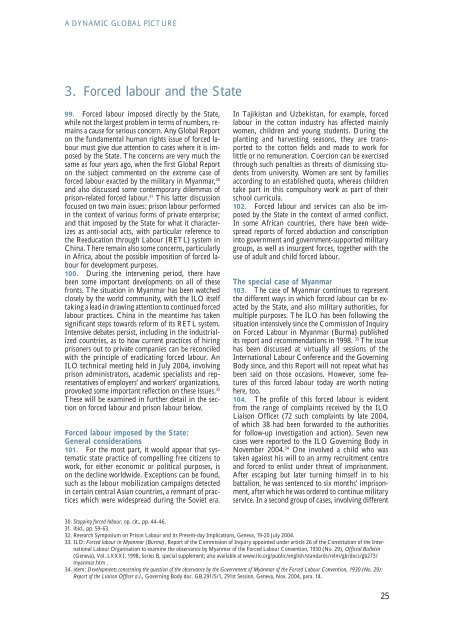A Global Alliance Against Forced Labour - International Labour ...
A Global Alliance Against Forced Labour - International Labour ...
A Global Alliance Against Forced Labour - International Labour ...
Create successful ePaper yourself
Turn your PDF publications into a flip-book with our unique Google optimized e-Paper software.
A DYNAMIC GLOBAL PICTURE3. <strong>Forced</strong> labour and the State99. <strong>Forced</strong> labour imposed directly by the State,while not the largest problem in terms of numbers, remainsa cause for serious concern. Any <strong>Global</strong> Reporton the fundamental human rights issue of forced labourmust give due attention to cases where it is imposedby the State. The concerns are very much thesame as four years ago, when the first <strong>Global</strong> Reporton the subject commented on the extreme case offorced labour exacted by the military in Myanmar, 30and also discussed some contemporary dilemmas ofprison-related forced labour. 31 This latter discussionfocused on two main issues: prison labour performedin the context of various forms of private enterprise;and that imposed by the State for what it characterizesas anti-social acts, with particular reference tothe Reeducation through <strong>Labour</strong> (RETL) system inChina. There remain also some concerns, particularlyin Africa, about the possible imposition of forced labourfor development purposes.100. During the intervening period, there havebeen some important developments on all of thesefronts. The situation in Myanmar has been watchedclosely by the world community, with the ILO itselftaking a lead in drawing attention to continued forcedlabour practices. China in the meantime has takensignificant steps towards reform of its RETL system.Intensive debates persist, including in the industrializedcountries, as to how current practices of hiringprisoners out to private companies can be reconciledwith the principle of eradicating forced labour. AnILO technical meeting held in July 2004, involvingprison administrators, academic specialists and representativesof employers’ and workers’ organizations,provoked some important reflection on these issues. 32These will be examined in further detail in the sectionon forced labour and prison labour below.<strong>Forced</strong> labour imposed by the State:General considerations101. For the most part, it would appear that systematicstate practice of compelling free citizens towork, for either economic or political purposes, ison the decline worldwide. Exceptions can be found,such as the labour mobilization campaigns detectedin certain central Asian countries, a remnant of practiceswhich were widespread during the Soviet era.In Tajikistan and Uzbekistan, for example, forcedlabour in the cotton industry has affected mainlywomen, children and young students. During theplanting and harvesting seasons, they are transportedto the cotton fields and made to work forlittle or no remuneration. Coercion can be exercisedthrough such penalties as threats of dismissing studentsfrom university. Women are sent by familiesaccording to an established quota, whereas childrentake part in this compulsory work as part of theirschool curricula.102. <strong>Forced</strong> labour and services can also be imposedby the State in the context of armed conflict.In some African countries, there have been widespreadreports of forced abduction and conscriptioninto government and government-supported militarygroups, as well as insurgent forces, together with theuse of adult and child forced labour.The special case of Myanmar103. The case of Myanmar continues to representthe different ways in which forced labour can be exactedby the State, and also military authorities, formultiple purposes. The ILO has been following thesituation intensively since the Commission of Inquiryon <strong>Forced</strong> <strong>Labour</strong> in Myanmar (Burma) publishedits report and recommendations in 1998. 33 The issuehas been discussed at virtually all sessions of the<strong>International</strong> <strong>Labour</strong> Conference and the GoverningBody since, and this Report will not repeat what hasbeen said on those occasions. However, some featuresof this forced labour today are worth notinghere, too.104. The profile of this forced labour is evidentfrom the range of complaints received by the ILOLiaison Officer (72 such complaints by late 2004,of which 38 had been forwarded to the authoritiesfor follow-up investigation and action). Seven newcases were reported to the ILO Governing Body inNovember 2004. 34 One involved a child who wastaken against his will to an army recruitment centreand forced to enlist under threat of imprisonment.After escaping but later turning himself in to hisbattalion, he was sentenced to six months’ imprisonment,after which he was ordered to continue militaryservice. In a second group of cases, involving different30. Stopping forced labour, op. cit., pp. 44-46.31. ibid., pp. 59-63.32. Research Symposium on Prison <strong>Labour</strong> and its Present-day Implications, Geneva, 19-20 July 2004.33. ILO: <strong>Forced</strong> labour in Myanmar (Burma), Report of the Commission of Inquiry appointed under article 26 of the Constitution of the <strong>International</strong><strong>Labour</strong> Organisation to examine the observance by Myanmar of the <strong>Forced</strong> <strong>Labour</strong> Convention, 1930 (No. 29), Offi cial Bulletin(Geneva), Vol. LXXXI, 1998, Series B, special supplement; also available at www.ilo.org/public/english/standards/relm/gb/docs/gb273/myanmar.htm .34. idem: Developments concerning the question of the observance by the Government of Myanmar of the <strong>Forced</strong> <strong>Labour</strong> Convention, 1930 (No. 29):Report of the Liaison Offi cer a.i., Governing Body doc. GB.291/5/1, 291st Session, Geneva, Nov. 2004, para. 14.25
















